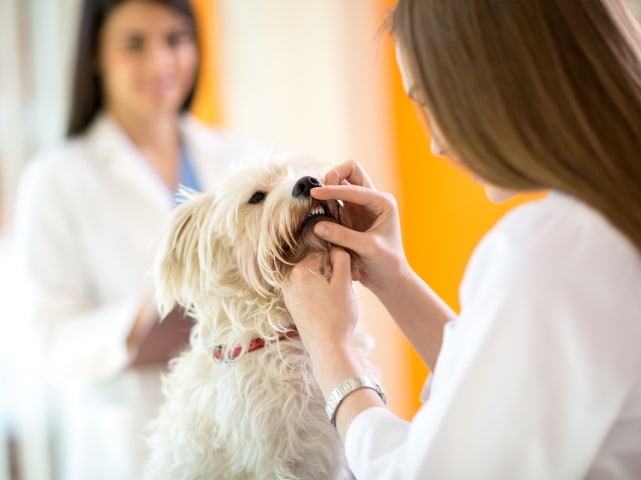While most of us probably take a routine trip to our dentist every 6 months or so for a preventative cleaning and check-up, many pet owners still carry some common misconceptions about the necessity of regular dental check-ups for our pets. Here, our Little Rock, Arkansas vets discuss some of the most common myths regarding your pet’s dental care.
Myth 1: If your pet’s teeth have not accumulated a significant amount of dental tartar, an annual anesthetized oral assessment and periodontal cleaning are not necessary.
The Truth: While a regular oral assessment and cleaning is necessary to remove calculus build-up, there are many problems with your pet’s teeth that cannot be seen by the naked eye, or without your pet under general anesthesia.
For one, it is difficult for a veterinarian to get a complete visual of the inside of your pet’s mouth while they are awake. Unlike when humans go to the dentist, your veterinarian cannot simply tell your pet to “say ahh” and see everything going on in your pet’s mouth. For example, if your pet has an oral mass that is far back and hidden under their tongue, your veterinarian may not be able to visualize and remove it while it is still small. A sedated oral exam isn’t always necessarily about the teeth. While your pet is under anesthesia, your veterinarian will be able to see the entirety of the mouth and have the potential to catch any problem areas early.

The second reason as to why this is a myth, is because you cannot see the entire structure of a tooth without dental radiographs. In fact, two thirds of your dog and cat’s teeth are under the gumline. Dental radiographs allow the veterinarian to assess the teeth for fractures, bone-loss, abscesses and other signs of internal disease. Any time your pet is receiving a periodontal cleaning, radiographs should be performed. A tooth can appear completely normal on the outside, but in fact have several problems revealed after a radiograph is performed.
Myth 2: If you have an older pet, it isn’t safe for them to go under anesthesia.
The Truth: It is very common for pet owners to think that their pet is “too old” to go under general anesthesia. As long as a proper pre-anesthetic work-up indicates that there are no underlying conditions that would put them at risk, the risk of anesthesia-related complications is low.
Severe dental disease has the potential to compromise more than just your pet’s mouth. Because bacteria from the mouth constantly enters the blood stream, it can also cause harm to your pet’s heart, liver, and kidneys. These diseases will often pose a larger risk to your pet than the anesthesia itself. Don’t let age be the reason why your pet doesn’t receive proper dental care.
Myth 3: If your pet isn’t acting like they’re in pain from their dental disease, they probably aren’t.
The Truth: Dogs and cats will often display pain differently than people do. With strong survival instincts, most pets will continue to eat and appear pain-free, in spite of having severe and painful periodontal disease. It is not usually until the pet’s dental disease has been properly addressed, that a pet owner will notice the positive changes in their pets.
In fact, we hear this all the time. Comments like “wow she is acting like a kitten again,” or “he hasn’t played like this in years” are constantly heard by our clients after their pet has had painful and diseased teeth removed.
Myth 4: If my pet has any of his teeth extracted, he will not be able to eat.
The Truth: Believe it or not, many dogs and cats do little extensive chewing of their food, prior to swallowing. If your pet enjoyed dry food before having extractions, they will more than likely be able to return to eating it after their extraction sites have healed. While we see dogs and cats do this all the time, owners are welcome to transition their pet to either a canned food or begin to moisten their dry food with some water, if they feel it makes eating easier for their pet. The primary goal is always going to be an improved quality of life for the pet.
Myth 5: Bad breath is normal for a dog and cat.
The Truth: While your pet’s breath will probably never smell minty fresh, any extreme odors should be evaluated by your veterinarian. Most pets with extremely foul-smelling breath will have some form of periodontal disease that needs to be addressed.
Myth 6: At-home dental care doesn’t matter, as long as I am getting routine dental care with my veterinarian.
The Truth: At-home dental care can make a huge difference in your pet’s mouth. While routine brushing is the gold-standard for reducing plaque, tartar, and diseased teeth, this is not always an easy task for a pet owner. If you cannot brush, talk to your veterinarian about a variety of VOHC-approved chews and oral rinses that can help care for your pet’s teeth in between their preventative visits with their veterinary dentist.
